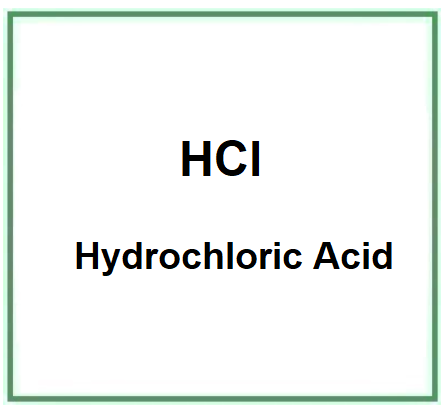E507 (Hydrochloric Acid) is a mineral acid found in the human body in gastric acid. It is a highly corrosive acid.
The name describes the structure of the molecule:
- "Hydro-" refers to hydrogen (H), which is the first element in the chemical formula of the acid.
- "Chloric" indicates that the acid contains chlorine (Cl), which is the second element in the chemical formula.
- "-ic" is a suffix commonly used in chemistry to denote the presence of an acid.
Hydrochloric acid also known as HCl, is a strong corrosive chemical and is typically produced by the direct synthesis of hydrogen chloride gas (HCl) and water (H2O). The process involves the following steps:
- Hydrogen Chloride Gas Production: Hydrogen chloride gas can be generated by the reaction of a chloride compound with an acid, such as sulfuric acid (H2SO4) or by burning hydrogen gas (H2) in chlorine gas (Cl2).
- Dissolution in Water: The produced hydrogen chloride gas is then dissolved in water. This reaction is highly exothermic and generates heat.
- Purification: The resulting solution is purified to remove impurities. This purification process may involve filtration, distillation, or chemical treatments to obtain a pure hydrochloric acid solution.
Industrially it appears as a colourless liquid

What it is used for and where
Food
Ingredient included in the list of European food additives as E507, acidifier.
Its use in the food industry is as an acidity correcting agent and also as a leavening agent. It is used as a reagent for dextrin, as a food additive/reagent.
It is added to cheeses to improve pH, but lactic acid, citric acid and others are usually used for this purpose. In 2007, EFSA requested explanations on the use of this additive. Conclusions of the Panel of Independent Experts on 'Food Additives and Processing Aids permitted in organic food processing from plants and animals' (1).
In 2012, the European Commission considered the amount of E507 to be 'quantum satis', i.e. with no Daily Allowable Dose constraints (2).
In 2017, EFSA requested a review of the characteristics of this additive with particular regard to : Method of manufacture, Impurities, Genotoxicity and others (3).
Cosmetics
Buffering agent. It is an iingredient that can bring an alkaline or acid solution to a certain pH level and prevent it from changing, in practice a pH stabiliser that can effectively resist instability and pH change.
- Molecular Formula HCl or ClH
- Molecular Weight 36.458
- CAS 7647-01-0
- EC Number 231-595-7
- PubChem Substance ID 24895478
- MDL number MFCD00011324
Synonyms:
- hydrogen chloride
- Muriatic acid
- Chlorohydric acid
- Anhydrous hydrochloric acid
- Hydrogen chloride (HCl)
References______________________________________________________________________
(1)https://ec.europa.eu/agriculture/organic/sites/orgfarming/files/docs/body/conclusions_food_additives_2007_en.pdf
(2) EUR-Lex - 32008R1333 - EN - EUR-Lex (europa.eu)
(3) Call for technical and toxicological data on miscellaneous food additives to be re-evaluated under the Regulation (EU) No 257/2010 EFSA-Q-number: EFSA-Q-2017-00618 Published: 1/08/2017
![]() E507
E507 


